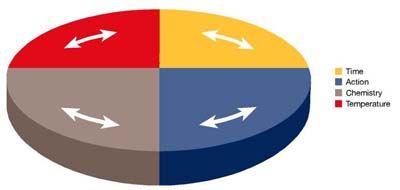Equipment Design and Appropriate Procedures Improve Cleaning
Equipment and Processing Report
Sterilization or sanitization is usually applied to kill bacteria in a system. Equipment is cleaned to remove residues from the previous batch of product, and subsequently flushed to remove the cleaning liquids. To ensure that sterilization and cleaning are efficient and safe, it is not enough to develop the appropriate procedures. Selecting the right manufacturing equipment further improves cost efficiency, as well as patient safety.
Sterilization or sanitization is usually applied to kill bacteria in a system. Equipment is cleaned to remove residues from the previous batch of product, and subsequently flushed to remove the cleaning liquids. To ensure that sterilization and cleaning are efficient and safe, it is not enough to develop the appropriate procedures. Selecting the right manufacturing equipment further improves cost efficiency, as well as patient safety.
The chosen equipment must minimize the risk of contamination due to inappropriate product-contact surfaces. Machines should not introduce airborne particles and dust into the environment, nor should they entail the risk that oil or other substances required for their operation will contaminate the product. If an operator cannot contact all equipment surfaces adequately, he or she simply cannot clean them. To facilitate efficient cleaning, equipment must be designed with this principle in mind.

The time, action, chemicals, and temperature (TACT) circle originally developed by Sinner in 1960 shows the cleaning effects that these parameters generate on the equipment surface (see Figure 1). The circle shows the extent to which time plus at least one more parameter clean residues from a surface. If one parameter is increased, the others may be reduced.
For example, if one dips one's greasy hands in water, they will not become clean. If one then puts them into a soap bath, they will become clean, but only after a long time. However, if one raises the temperature of the soap bath, one's hands will become clean more quickly. But if one then also rubs one's hands together, they will become clean even more quickly.
The residue and the product-contact surface determine the size, or the impact, needed for the cleaning process. The most suitable type of chemicals and the appropriate temperature are decided according to the residue. High surface action enables the chemicals and temperature to work better, which makes it possible to reduce both of these parameters, as well as the cleaning time. Because the action is often built into the equipment design, selecting the right equipment can reduce the cost and increase the cleanability of a system.
Cleaning action on the equipment surface is achieved by generating high velocity or flow of cleaning fluids on all product-contact surfaces. This technique distributes the chemicals and temperature better than low velocity does. Increased velocity also generates high turbulence and shear force on the surface, which ensures that the chemicals and temperatures reach deep into the residues and dissolve or detach them safely and efficiently.
To test the influence of the TACT parameters, the author designed a tank-cleaning test incorporating two tank-cleaning devices that generated different amounts of action. A static spray ball typically generates a wall shear stress of 2–5 Pa (i.e., falling film stress, depending on liquid temperature). A rotating jet head typically generates a wall shear stress of 40–1000 Pa (i.e., jet impingement, depending on jet pattern mesh).
To clean the tank sufficiently, two static spray balls operated for 48 min at a flow rate of 20 m3/h and a pressure of 2.5 bar. But one rotating jet head achieved better results when it operated for 14 min at a flow rate of 6 m3/h and a pressure of 5.0 bar (see Figures 2 and 3 and Table I).



The test shows that the theory of the TACT circle works in practice. To clean a certain residue from a certain surface, the parameters in the TACT circle can be adjusted for cost optimization (see Figure 3). With increased action, it was possible to reduce the time, the amount of chemicals, and the heating energy and still achieve an equal or better result. High shear forces can remove residues from most surfaces by themselves, without chemicals or high temperatures. This technique can reduce the risk of contamination and dramatically reduce cleaning costs.
Per-Åke Ohlsson is global manager for Alfa Laval’s Pharma and Personal Care Market Unit, Box 74, Rudeboksvägen 1, SE-221 00 Lund, Sweden, tel. +46 46 36 74 18, [email protected]
Drug Solutions Podcast: A Closer Look at mRNA in Oncology and Vaccines
April 30th 2024In this episode fo the Drug Solutions Podcast, etherna’s vice-president of Technology and Innovation, Stefaan De Koker, discusses the merits and challenges of using mRNA as the foundation for therapeutics in oncology as well as for vaccines.
Pharmaceutical Tariffs Are Imminent: How Industry is Bracing for Impact
April 16th 2025On April 14, 2025, the Trump Administration launched a national security-driven investigation into pharmaceuticals, a move that will likely result in tariffs being placed on pharmaceutical drugs, ingredients, and other components that are imported from outside of the United States.